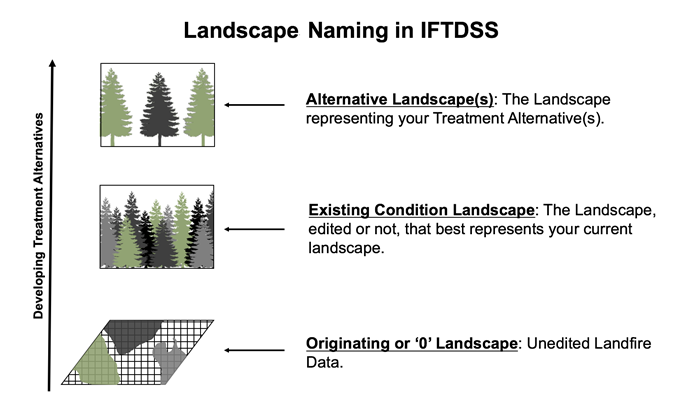Landscape Terminology in IFTDSS
Note: Some terms are not mutually exclusive.
NB Landscapes
Landscapes that are not buffered are identified throughout IFTDSS by the acronym "NB" appearing at the end of the landscape name. "NB" indicates "No Buffer." NB landscapes come into IFTDSS by way of:
-
Uploaded landscapes in which the "Apply Buffer" option was not used.
-
Landscapes created in earlier versions of IFTDSS (prior to the Version 3.1.1, 25 October 2018) before buffered was automatically added to created landscapes.
Starting Landscape
"Starting Landscape" is any landscape chosen as the starting point for a landscape editing session. This term is used for both edited and unedited landscapes, and you will often see it next to the landscape dropdown menu when you begin edits in IFTDSS. In the Landscape Edit task of Landscape Evaluation, any landscape may be chosen as a starting landscape. In the landscape editing portion of the Develop Treatment Alternatives task of Strategic Planning session, the starting landscape choices will be limited to landscapes that match the geographic extent of the Originating landscape (explained below).
Tip: Not sure if you're looking at an edited or unedited landscape? You can determine if editing rules have been applied by selecting the landscape in question from My Workspace View and then clicking the view edit rules button.
Unedited Landscape (LANDFIRE)
"Unedited Landscape (LANDFIRE)" describes a landscape created by IFTDSS that has not been edited or alternated in any way. This is the landscape that you first create, specifying the size and name. These are the only landscapes available to choose from in Develop Treatment Alternatives when you are prompted to “Pick Landscape”. IFTDSS will always retain this original version under the name you have chosen.
When naming Unedited Landscapes, its wise to use a naming convention that reflects both the geographic extent/project area and a LANDFIRE version. For example, naming a landscape Horse Ridge LF2014 to describe a landscape for the Horse Ridge project area created with LANDFIRE Version 2014 data.
Edited (Alternative) Landscape
"Edited (Alternative) Landscape" describes an edited landscape. When landscape edits are made, a new landscape is saved reflecting the edit rules applied during your editing session. The "Alternative" term is often seen in the context of the Developing Treatment Alternatives task, where edits are made to either create an Existing Condition (EC) landscape (defined below) or to reflect post-treatment conditions that would result from a fuel treatment alternative. You may check to see if editing rules have been applied to a landscape from My Workspace by selecting the landscape and then clicking the view edit rules button.
We recommend appending a landscape name with a short abbreviation describing your edits, such as .".... - LowSevFire 1Yr post"
Existing Condition (EC) Landscape
"Existing Condition (EC) Landscape" is term used mostly in Developing Treatment Alternatives, it refers to a landscape that represents, as closely as possible, the current condition of your landscape. It may be an edited landscape, or unedited. Unedited landscapes can be used to represent EC if you determine the raw LANDFIRE data is current and accurate for your analysis purposes. You will see this term used when comparing treatment alternatives in IFTDSS.
We recommend added EC to the landscape name for easy identification, such as "Horseshoe Ridge LF2014 - EC"
Originating Landscape (Zero "0" landscape)
"Originating Landscape (Zero “0” landscape)" is a term used mostly in Developing Treatment Alternatives, it refers to the unedited landscape you select to begin developing treatment alternatives. In the Developing Treatment Alternatives task it is tagged with a zero ![]() icon. It defines the extent of your comparison, so any landscapes that match the extent of your originating landscape will become available during Developing Treatment Alternative task.
icon. It defines the extent of your comparison, so any landscapes that match the extent of your originating landscape will become available during Developing Treatment Alternative task.
The graphic below outlines the different types of landscapes in IFTDSS that are used in the Develop Treatment Alternative task.

Landscape Family
The term "landscape family" describes a collection of landscapes with the same extent that you accumulate as you create your Unedited landscape, Edited landscape, Originating landscape, and/or Existing Condition landscape. To phrase it in terms of planning, landscape family would include your existing landscape and the alternatives versions you create in IFTDSS to represent various fuel treatment scenarios. You may encounter this term when comparing various landscapes or treatment alternatives in IFTDSS.